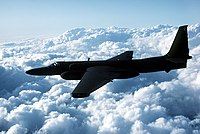
Photo from wikipedia
Abstract We aimed to identify potential physiological and performance differences of trained cross-country skiers (V˙o 2max =60±4 ml ∙ kg –1 ∙ min –1 ) following two, 3-week long altitude modalities: 1) training… Click to show full abstract
Abstract We aimed to identify potential physiological and performance differences of trained cross-country skiers (V˙o 2max =60±4 ml ∙ kg –1 ∙ min –1 ) following two, 3-week long altitude modalities: 1) training at moderate altitudes (600–1700 m) and living at 1500 m (LMTM;N=8); and 2) training at moderate altitudes (600–1700 m) and living at 1500 m with additional nocturnal normobaric hypoxic exposures (FiO 2 =0.17;LHTM; N=8). All participants conducted the same training throughout the altitude training phase and underwent maximal roller ski trials and submaximal cyclo-ergometery before, during and one week after the training camps. No exercise performance or hematological differences were observed between the two modalities. The average roller ski velocities were increased one week after the training camps following both LMTM (p=0.03) and LHTM (p=0.04) with no difference between the two (p=0.68). During the submaximal test, LMTM increased the Tissue Oxygenation Index (11.5±6.5 to 1.0±8.5%; p=0.04), decreased the total hemoglobin concentration (15.1±6.5 to 1.7±12.9 a.u.;p=0.02), and increased blood pH (7.36±0.03 to 7.39±0.03;p=0.03). On the other hand, LHTM augmented minute ventilation (76±14 to 88±10 l·min −1 ;p=0.04) and systemic blood oxygen saturation by 2±1%; (p=0.02) with no such differences observed following the LMTM. Collectively, despite minor physiological differences observed between the two tested altitude training modalities both induced comparable exercise performance modulation.
Journal Title: International Journal of Sports Medicine
Year Published: 2022
Link to full text (if available)
Share on Social Media: Sign Up to like & get
recommendations!